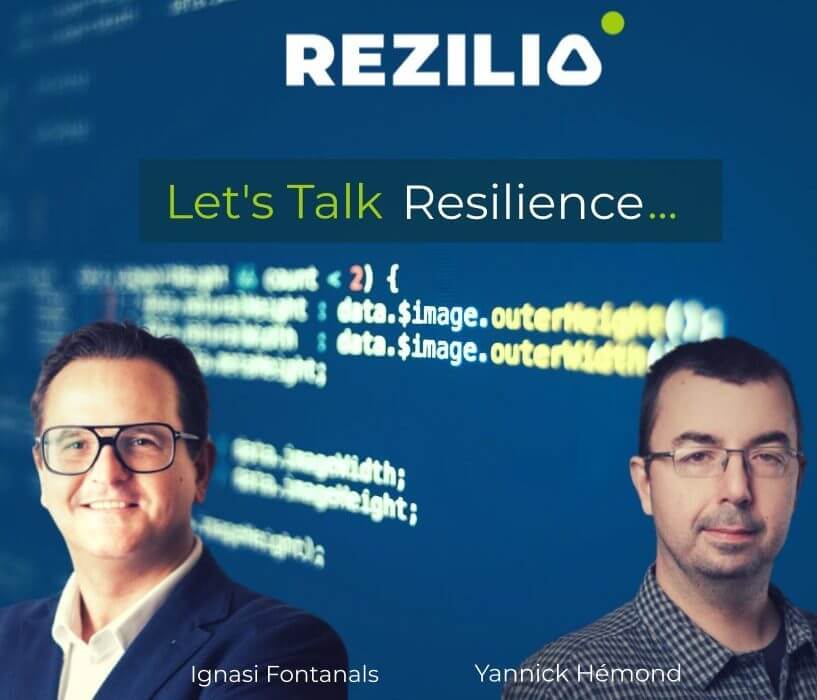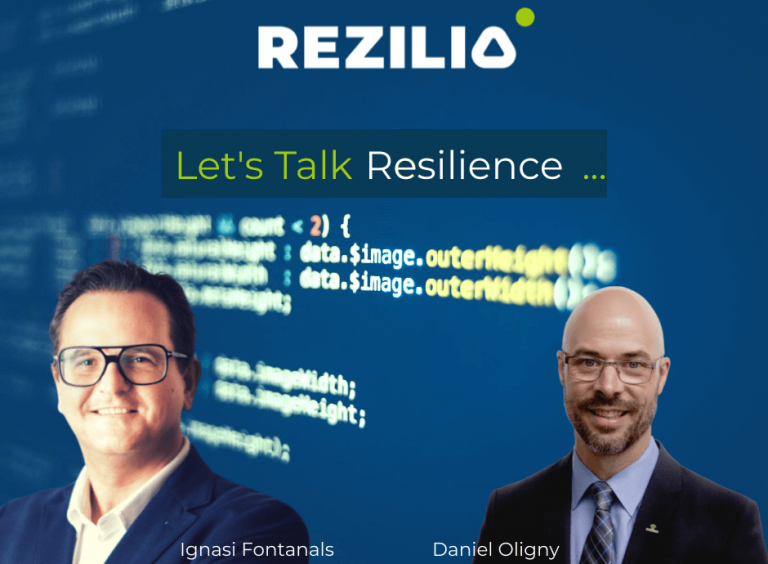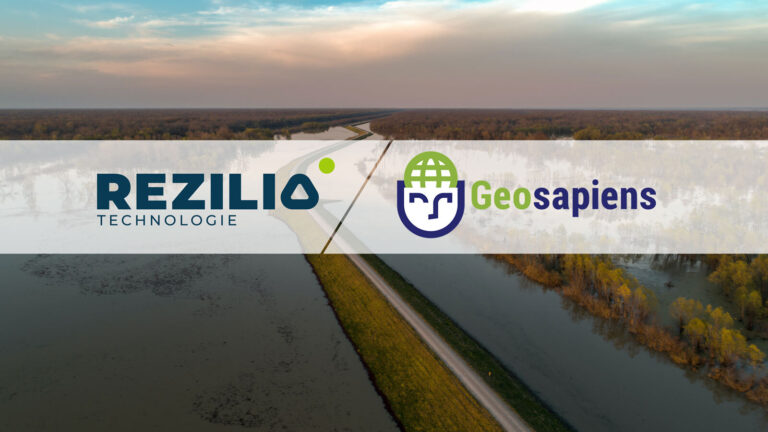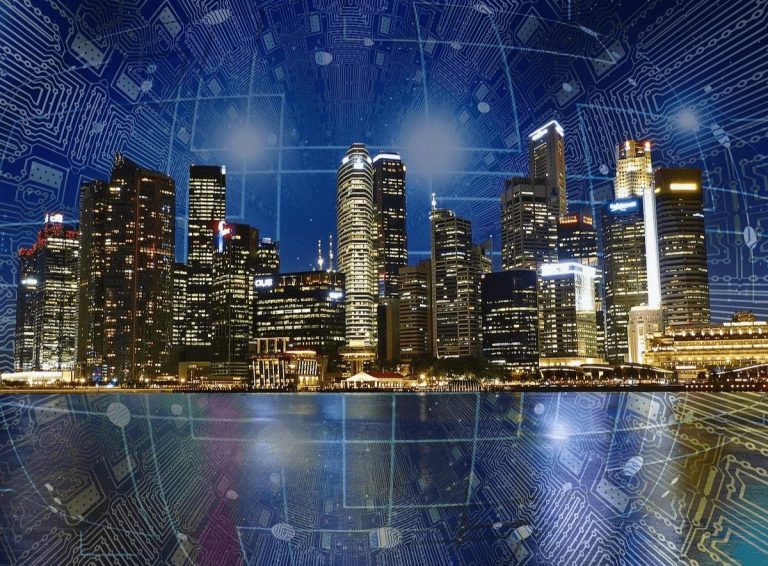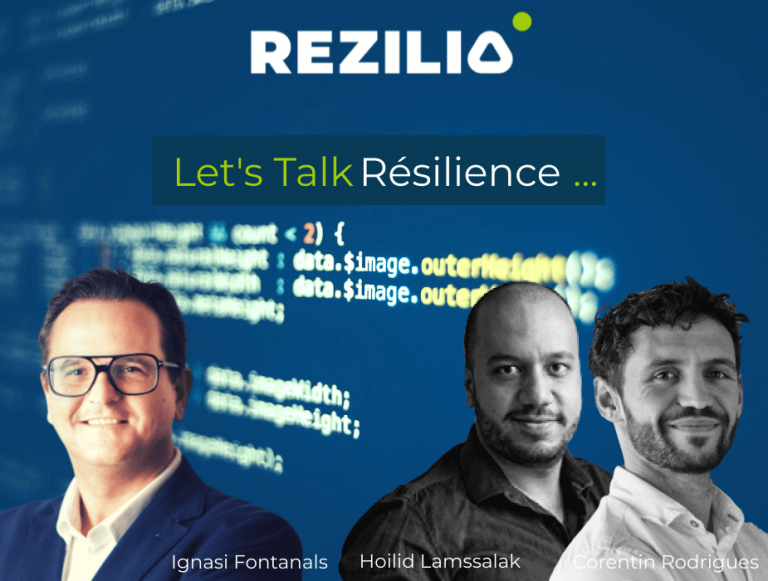« When technology comes to support the organization, it becomes very powerful. »
Let’s Talk Resilience is the new section of our blog where we receive guests to talk (…of course) about resilience. Today it’s Ignasi Fontanals ( Director Europe of Rezilio Technology ) who talks with Yannick Hémond ( Professor – Resilience at UQAM ) about his background, his vision of resilience in the future and about the event of the year in Quebec which will be the Disaster and Resilience 2021 conference.
(A liberty of adaptation has been taken to make the text coherent but no words have been changed)
IGNASI – Hello Yannick, welcome to Let’s Talk Resilience. Could you introduce yourself?
YANNICK – Hello, thank you. I am a professor in the geography department since 2019. I work in resilience, risk and disasters so these are my research areas. I’m very interested in the notion of management capacity and how organizations can maintain their resilience through time .
IGNASI.- So tell us a little bit about yourself, how did you get into resilience and why did you choose these fields?
YANNICK. It goes back a long way, in Quebec what is typical is that everyone talks about the ice storm of ’98, so a lot of people got interested in the issue in ’98 with the ice storm, which brought a huge campaign that led to a power cut, more than 300 municipalities were affected and more than half of Quebecers did not have electricity … So from that moment on, I said to myself: what can we do to manage this type of event and how to make it so that the consequences are the least serious possible for the population… and one thing lead to another… I start to study this field, so a master’s degree in industrial engineering, including critical infrastructures.
THE CONCEPT OF RESILIENCE
“Resilience deals with how a company, an organization, or a system does to function in an environment that is known to be constantly changing, either in a positive or negative way”
IGNASI.- Very well, so explain to us, then, after all this experience what is your definition of resilience…. since you know that everyone has a definition of resilience…?
YANNICK – Oh yes, that’s for sure, it’s specific to research. …. What I’m using at the moment is really the capacity to maintain an acceptable functioning in an environment that is in constant change, so I’m interested in knowing how a company or an organization or a system do to function in an environment that we know is in constant change, either in a positive or negative way, so we can have a positive or negative resilience at this level, and I work with organizations on this approach.
“We need to have as many people as possible around the table to discuss resilience”
IGNASI.- So about these organizations and these actors in the resilience space, could you talk a little bit more about who are from your point of view the main actors of resilience? Over the years they have evolved, who are the main ones now? Do you think that there are new actors who are entering the area of resilience?
YANNICK: Since the beginning we have always been working with all those who want to work on resilience. You know that resilience is a collective thing, so you have to have as many people as possible around the table to discuss about it and you need to have as many organizations as possible: for example small and medium companies, large corporations, critical infrastructures, the population, the political side, the public administration. …so the more people the better, and we see it over time that the notion of community resilience that has emerged and has been very much strengthened by the Sendai framework since 2015…so it’s everybody that has to work on resilience ….more and more people are sitting around the table.
INNOVATION IN RESILIENCE
“We’re still figuring out who is the best facilitator of a resilience community so that innovations are sustainable”
IGNASI.- All right, so it’s that notion to sit around the table and share that will bring us to talk a bit about innovation in resilience. What are your thoughts about innovation in the resilience space? Is it accelerating? It’s something that is very difficult because it’s an environment where the traditional players (Firts Responders) belong to sectors that are difficult to innovate. ….? Tell us a little bit about this notion of moving from research to innovation.
YANNICK: In fact, this is gradually being done in Quebec, among other places, and it is very much in the form of developing performance indicators. We will also try to see what’s next with the new ISO (International Standards Organization), but the main challenge is really the time frame. In an innovation process on resilience, the transfer of research to this space is done well, but what is difficult is that once we are no longer there, it often fades away and it is very difficult. In fact, this is where we see the importance, when we talk about the resilience of a community, of having a facilitator for this community, and we are still looking for the best facilitator for a group of organizations so that, over time, innovation wil be sustainable. We have difficulties in making innovations sustainable, this is our main difficulty.
IGNASI – Tell us the differences between Europe and Canada or Europe and the Americas at this level.
YANNICK: What we see as a big difference is really at the normative and legislative level, so the framework that the public administration will give. In Europe there are more standards. If you look at the BSI (UK), for example, which produces standards, even the Business Continuity Institute, and at the European level, the European Commission also produces many prevention directives, much more so than in Quebec. It’s always been the same, but even in Canada we are lucky, in our misfortune, in that we don’t have many very disruptive events. We don’t have a lot of risk generators in Canada compared to Europe where there are a lot of risky industries. There are also many events that affect European countries, for example, just the nuclear industry. If in Canada we have lets say two power plants, we wonder if these are the jobs of the future or not, in Europe there are many more risk generating activities. In Europe, it’s much more regulated and we really see a much more advanced development of indicators than in North America.
TECHNOLOGY
“Technology must adapt to the organization, not the other way around”
IGNASI: So let’s talk about technology. I know you have a specific vision of technology. We are Rezilio “Technology” and we believe in technology even in its “sober” use. So how do you see technology applied to resilience, this marriage, this conjunction of technology and resilience?
YANNICK: That’s a really interesting question because I’m basically a systems developer, so my background is in systems administration and development and I’ve always said that technology should not be an end in itself. Technology must adapt to the organization and not the other way around, when this is done, technology becomes very powerful for the organization. You have to understand that in resilience there are different ways of functioning, of managing… you can’t force an organization to function against nature… when technology comes to support its functioning, that’s when technology allows you to break the boundaries and allows this whole comparative side, we see it a lot in the United States. They have a resilience assessment and they allow us to compare regions, industries and types of organization. It’s really interesting at that level and it gives a kind of leverage effect to be competitive in terms of “am I resilient or not”.
“The use of open data and artificial intelligence should allow for better situational awareness”
IGNASI.- Do you have a specific technology that you would like to stress ? we heard a lot about algorithms, deep learning, open data, blockchain …
YANNICK – Actually, it’s interesting that you ask me that, I think I’m going to work on my research projects on the notion of open data used in geographic information systems (GIS) to help organizations understand their close environment. I think that technology, especially with all this artificial intelligence capacities, should allow to have a better knowledge of the situation (the famous “Situational Awareness”), and that can provide to the organization with the whole changing environment awarness. So afterwards, the organization will just have to know how to maintain its functions in this changing environment thanks to this situational awareness that the system will provide. Among other things it will be possible to do it with open data, maybe with a bit of artificial intelligence to understand the environment, but always at the service of the organization and not the opposite. Technology must be at the service of the organization.
DISASTER AND RESILIENCE 2021
“DR21 was born to bring together the scientific community but also practitioners from the French and English speaking side”
IGNASI.- Very interesting, [at Rezilio we are working precisely with this approch in our solutions] and so to finish you can explain us the Disaster and Resilience 2021 esummit. How it was created and to which audience it is addressed?
YANNICK: Actually it’s funny because we started to work on this event two years a go and normally it was supposed to be held last year in person, in 2020 in June, in the middle of a pandemic. Here in Quebec we were at the end of the first wave, travel was not possible and everything changed -as it did for everyone! and we reinvented ourselves to make an online event this year, which will take place from June 14 to 18. The summit was born after detecting the need to bring together the scientific community but also practitioners from the Francophonie and from the Anglophone side as well, and still around the notion of disaster and resilience and what’s next. We are at the mid-term of the Sendai Framework (2015-2030), and here in Quebec we are at the end of a policy in Civil Security for a more Resilient Quebec. So there are different elements that are being set that make this event really interesting. We wanted to invite the international community to discuss with us on different subjects related to disasters and resilience.
IGNASI – If you want to register, what should you do ?
YANNICK – To register is very simple, you go to the DR2021 website and you can register. We want to keep the costs to a minimum, so it’s $100 (68 €) per person for a week of conferences. There are more than thirty conferences, workshops …. so it’s not just listening to someone speaking, it’s also an opportunity to participate in co-creation workshops where you will be able to interact with the panelists, so it’s also that and it will be really interesting. There will be an exhibitors’ lounge with our partners and we are even organizing a geomatics and risk management technology showcase to bring the entire municipal community together to share their good advice in this field.
IGNASI – Finally, tell us a little about your university couses about resilience.
YANNICK: I run a program in resilience, crisis and disasters, so a graduate program that we call here in Quebec, and which I think is the equivalent of a master’s degree in Europe, and a formula for those who would not want to embark on too long programmes.
IGNASI.- Thank you very much and looking forward to see you at the DR2021 event from June 14 to 18 !
???? Rezilo is Partner of DR21 and is organizing à the roundtable (in french) “Comment relancer une nouvelle résilience structurelle et intelligente ?” 17 june 13:00 (EDT) – 19h (GMT +2) Get more info.
???? To register for the DR2021 event and attend our session simply go to https://sites.grenadine.uqam.ca/sites/egide/en/dr2021/register and register for the summit. Email us at info@rezilio.com to get a 25% discount for the full week ticket.
???? To get information about REZILIO you can request a full demo https://www.rezilio.com/en/discover-rezilio/
